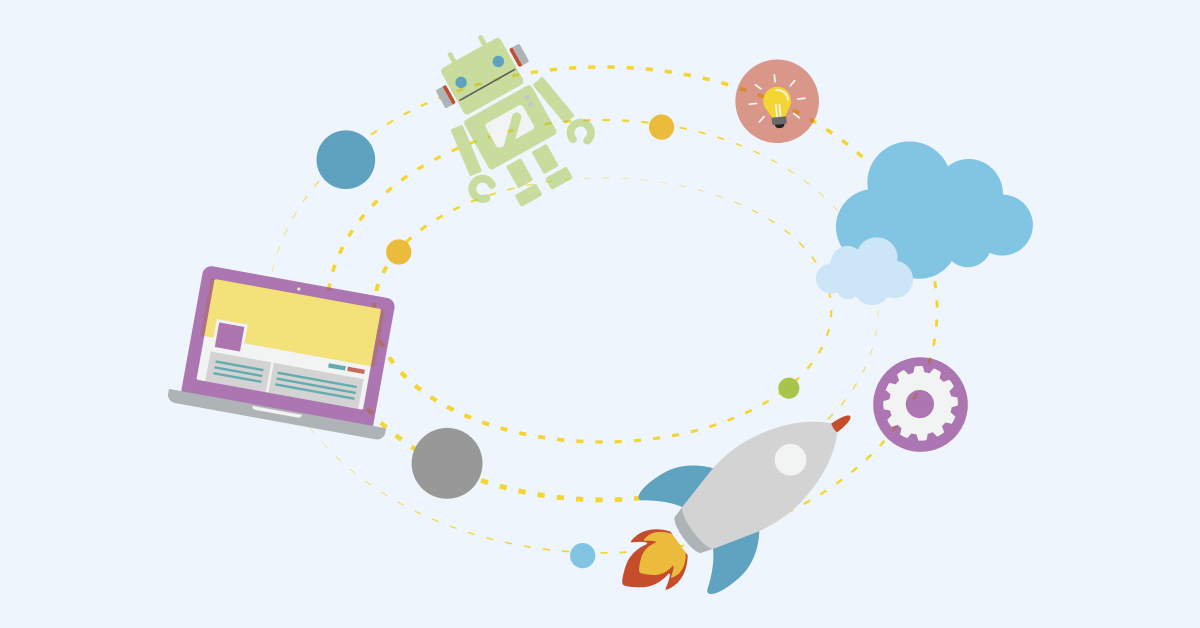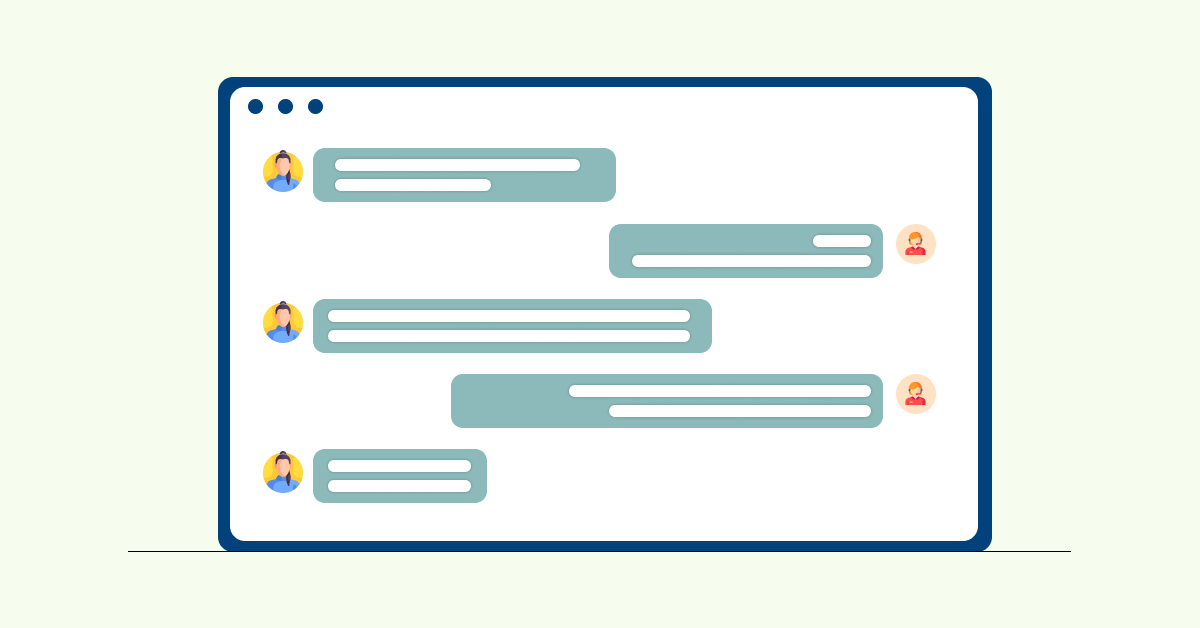1. Personalize the Customer Journey
A way to offer a great customer experience is by personalizing the customer journey through digital transformation. 59% of online shoppers believe that it’s easier to find more interesting products in personalized online stores. Companies can enhance their customer satisfaction levels by tailoring interactions to meet the specific needs and preferences of individual customers.
Let’s take the example of an e-commerce company. They can personalize the customer journey by sending targeted email campaigns based on a customer’s past purchases or browsing behavior. Recommending similar products or offering exclusive discounts allows the company to make the customer feel understood and valued, increasing the likelihood of a purchase.
Pro tips:
- Segment the customer base: Divide the customers into distinct groups for more targeted and relevant personalization efforts.
- Leverage automation and AI: Use automation or artificial intelligence technologies to deliver personalized content, recommendations and offers in real time.
- Incorporate personalization across channels: Ensure the personalization efforts are consistent across all channels.
2. Implement Chatbots and AI Assistants
The integration of chatbots and AI assistants has revolutionized the way businesses interact with their customers, making it an essential element in customer experience digital transformation. The automated tools are designed to simulate human conversation and provide instant assistance to customers, enhancing their overall experience. They bring a significant reduction in customer wait time and frustration as well.
A perfect example of the effective use of chatbots and AI assistants can be observed in the e-commerce industry. Companies such as eBay have successfully integrated these technologies to assist customers in finding products, providing personalized recommendations and processing orders. It has not only improved customer satisfaction but has also resulted in increased sales and revenue.
Pro tips:
- Design a conversational user interface: Create chatbot scripts that are conversational and friendly, mimicking human-like interactions.
- Regular maintenance and updates: Regularly update the scripts and algorithms to enhance their effectiveness in providing solutions to customer queries.
- Human oversight: Implement a system that allows seamless escalation to human agents when necessary, ensuring complex issues are appropriately addressed.
3. Offer Omnichannel Support
Omnichannel support is important because it allows businesses to meet their customers where they are. Offering multiple communication channels such as phone, email, live chat and more, allows businesses to cater to the preferences of different customers. It not only enhances convenience for customers but also improves their satisfaction as they can reach out to the company through their preferred channel.
Imagine the scenario where a customer might start a conversation with a company through live chat and then continue it later via email or phone. All interactions are integrated with omnichannel support, ensuring that customers do not have to repeat themselves, saving time and effort.
Pro tips:
- Multi-channel integration: Integrate different channels to create a unified platform for customer interactions.
- Integrate technologies: Invest in reliable technology and customer relationship management (CRM) systems for seamless data integration.
- Train the employees: Train customer service teams to handle various channels and provide consistent support.
4. Provide Self-Service Options
The importance of self-service options lies in the fact that they empower customers to take control of their own experiences. Whether it’s accessing FAQs, troubleshooting guides, or online chatbots, customers appreciate the ability to find answers and resolve issues on their own. 67% of customers prefer self-service over speaking to a company representative.
An example of self-service options in action is the banking industry. Many banks now offer online banking platforms and mobile apps that allow customers to perform various transactions at their convenience. It eliminates the need for customers to visit physical branches or contact customer support, saving them time and effort.
Pro tips:
- User-friendly interface: Ensure that the self-service portal or platform is easy to navigate and search. A cluttered or confusing interface will only deter them from using self-service options.
- Comprehensive knowledge base: Include step-by-step guides, FAQs and troubleshooting tips to provide comprehensive self-help resources.
- Interactive tools: Consider incorporating interactive tools such as video tutorials or live chatbots to guide customers through complex processes.
5. Optimize Website and Mobile Experience
Optimizing website and mobile experience has become essential for businesses to offer a great customer experience. The rapid advancement of technology and the increasing use of mobile devices have led to customers having higher expectations when it comes to accessing brands online. A well-optimized website provides a positive user experience, leading to increased customer satisfaction and loyalty.
Consider a retail company that optimizes its website for mobile devices. Implementing a responsive design, streamlined navigation, and fast-loading pages, makes it easy for customers to make purchases on their smartphones or tablets. The result is a significant increase in mobile sales and customer engagement.
Pro tips:
- Responsive design: Ensure that the website or mobile app is designed to adapt seamlessly to different devices and screen sizes.
- Fast loading speed: Optimize the website and mobile app to load quickly, as slow loading times can significantly impact user experience.
- Intuitive navigation: Design an intuitive and user-friendly interface that allows customers to easily navigate through the digital platforms.
6. Implement Live Chat
Live chat allows businesses to connect with their customers in real-time, providing instant support, answering queries, and resolving issues promptly. The mode of communication is not only convenient for customers but also for businesses, as it can lead to increased customer engagement and loyalty. Live chat plays a crucial role in customer experience digital transformation.
An excellent example of the use of live chat is in the e-commerce industry, where customers often have questions about products, shipping, or returns. Offering live chat support allows businesses to address concerns immediately, leading to higher customer satisfaction and ultimately increased sales.
Pro tips:
- Integration: Ensure that live chat is seamlessly integrated into the website or app. Make it easily accessible and visible to customers, ideally appearing on every page.
- Quick response time: Customers expect prompt responses, so it’s crucial to prioritize quick resolution times.
- Proactive engagement: Utilize proactive chat invitations to offer assistance before customers even ask for it. The proactive approach can enhance the customer experience and potentially increase conversions.
7. Use Customer Feedback Surveys
Customer feedback surveys hold immense importance as they provide businesses with a direct line of communication with their customers. Actively seeking the opinions of the customers allows businesses to gain a deeper understanding of their target audience and tailor their strategies accordingly. It not only boosts customer satisfaction but also leads to improved brand loyalty and increased customer retention.
An example of the power of customer feedback surveys is seen in the hospitality industry. Hotels or restaurants can utilize surveys to gather feedback on various aspects such as customer service, cleanliness and menu options. Analyzing the data allows businesses to identify areas for improvement and implement changes that directly address customer concerns.
Pro tips:
- Keep it concise: Customers are more likely to respond to shorter surveys. Keep the questions concise and to the point to maximize the response rate.
- Ask open-ended questions: Along with multiple-choice questions, include open-ended questions to allow customers to provide detailed suggestions.
- Act on the feedback: Share the results with relevant teams and implement necessary changes to address customer concerns.
8. Continuously Innovate and Adapt
The importance of continuous innovation and adaptation lies in the fact that customer preferences are constantly changing. Customers now expect seamless and personalized experiences across multiple touchpoints with the advancements in technology. Businesses can stay ahead of the curve by continuously innovating and adapting. It will ensure they are providing customer experiences that are relevant and meaningful.
An excellent example of a company that continuously innovates and adapts to offer a great customer experience is Amazon. From its early days as an online bookstore to the tech giant it is today, Amazon has constantly evolved its business model and offerings. They have introduced various innovations such as same-day delivery, one-click ordering, and personalized product recommendations, all aimed at enhancing the customer experience.
Pro tips:
- Stay updated: Being aware of the latest trends and technologies allows businesses to anticipate customer needs . Stay informed through industry publications, attending conferences and engaging in market research.
- Promote a culture of innovation: Encourage open communication and idea-sharing amongst employees by creating a safe space for creativity.
- Embrace agile methodologies: Adopting agile practices allows for quick iterations and adjustments based on changing customer demands.
Revolutionize the Business with CX Digital Transformation
CX digital transformation has the power to revolutionize the business and take it to new heights. Embracing the latest technologies and implementing customer-centric strategies have resulted in driving growth for businesses of various industries. The key to success lies in understanding the customer’s needs, investing in digital marketing initiatives and continuously evolving to meet changing market demands.
Digital transformation can unlock endless opportunities for your business with the right tools, skills, and mindset. So don’t hesitate to embark on the transformative journey today and witness the incredible impact it can have on the bottom line.














